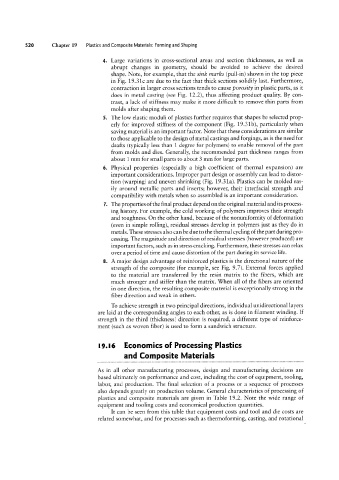Page 540 - 04. Subyek Engineering Materials - Manufacturing, Engineering and Technology SI 6th Edition - Serope Kalpakjian, Stephen Schmid (2009)
P. 540
20 Chapter 19 Plastics and Composite Materials: Forming and Shaping
4. Large variations in cross-sectional areas and section thicknesses, as well as
abrupt changes in geometry, should be avoided to achieve the desired
shape. Note, for example, that the sink mar/es (pull-in) shown in the top piece
in Fig. 19.31c are due to the fact that thick sections solidify last. Furthermore,
contraction in larger cross sections tends to cause porosity in plastic parts, as it
does in metal casting (see Fig. 12.2), thus affecting product quality. By con-
trast, a lack of stiffness may make it more difficult to remove thin parts from
molds after shaping them.
5. The low elastic moduli of plastics further requires that shapes be selected prop-
erly for improved stiffness of the component (Fig. 19.31b), particularly when
saving material is an important factor. Note that these considerations are similar
to those applicable to the design of metal castings and forgings, as is the need for
drafts (typically less than 1 degree for polymers) to enable removal of the part
from molds and dies. Generally, the recommended part thickness ranges from
about 1 mm for small parts to about 3 mm for large parts.
6. Physical properties (especially a high coefficient of thermal expansion) are
important considerations. Improper part design or assembly can lead to distor-
tion (warping) and uneven shrinking (Fig. 19.31a). Plastics can be molded eas-
ily around metallic parts and inserts; however, their interfacial strength and
compatibility with metals when so assembled is an important consideration.
7. The properties of the final product depend on the original material and its process-
ing history. For example, the cold working of polymers improves their strength
and toughness. On the other hand, because of the nonuniformity of deformation
(even in simple rolling), residual stresses develop in polymers just as they do in
metals. These stresses also can be due to the thermal cycling of the part during pro-
cessing. The magnitude and direction of residual stresses (however produced) are
important factors, such as in stress cracking. Furthermore, these stresses can relax
over a period of time and cause distortion of the part during its service life.
8. A major design advantage of reinforced plastics is the directional nature of the
strength of the composite (for example, see Fig. 9.7). External forces applied
to the material are transferred by the resin matrix to the fibers, which are
much stronger and stiffer than the matrix. When all of the fibers are oriented
in one direction, the resulting composite material is exceptionally strong in the
fiber direction and weak in others.
To achieve strength in two principal directions, individual unidirectional layers
are laid at the corresponding angles to each other, as is done in filament winding. lf
strength in the third (thickness) direction is required, a different type of reinforce-
ment (such as woven fiber) is used to form a sandwich structure.
l9.l6 Economics of Processing Plastics
and Composite Materials
As in all other manufacturing processes, design and manufacturing decisions are
based ultimately on performance and cost, including the cost of equipment, tooling,
labor, and production. The final selection of a process or a sequence of processes
also depends greatly on production volume. General characteristics of processing of
plastics and composite materials are given in Table 19.2. Note the wide range of
equipment and tooling costs and economical production quantities.
It can be seen from this table that equipment costs and tool and die costs are
related somewhat, and for processes such as thermoforming, casting, and rotational

